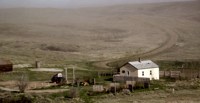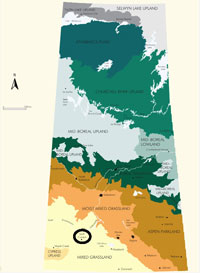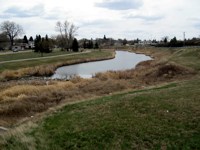Swift Current
Community Assessment & Adaptation Options:
Swift Current is located in southwestern Saskatchewan on the Swift Current Creek within the Mixed Grassland Ecoregion. Swift Current is a major manufacturing and service centre catering to the surrounding region that supports agriculture, oil, gas and wind farm development, along with major national and provincial parks (e.g. Grasslands and Saskatchewan Landing respectively) and tourism attractions (e.g. Eastend, Great Sand Hills).
The Mixed Grassland Ecoregion extends south into the United States and is dominated by agricultural use. Nearly 50% of the ecoregion is cultivated while the remainder is largely rangeland or designated parkland or protected areas. Irrigation is a major water user and there are many dams and reservoirs present. The ecoregion is important wildlife habitat for both upland and waterfowl species. Outdoor recreation and tourism are growing economic sectors. Some other service communities within the ecoregion, such as Maple Creek and Assinniboia, are thriving.
Climate Normals (1971-2000)
- The average daily temperature ranges from -12.4°C in January to 18.1°C in July with 5 months being below 0 (November to March). The lowest average daily minimum temperature is -17°C experienced in January and the highest average daily maximum temperature of 25°C is experienced in August.
- The annual precipitation is about 350 mm of which 75% is rainfall and the remainder is snow. 50% falls in the months of April, May, June, July.
- The average monthly wind speed is between 17.6 (August) and 22.2 km/hr (January)
- An indication of the demand for cooling and heating is provided by the number of degree-days above 18°C - 130; and the number of degree-days below 18°C - 5251.
- There are a total of 2179 sunshine hours per year with a minimum of 23 days of measurable sunshine in December and over 30 days in July.
Future Climate
Over the century to 2100 climate scenarios suggest:
- A warmer climate - temperatures may generally rise 2 to 4 degrees.
- A longer growing season - but drier despite a marginal increase in precipitation. This is a result of increased temperatures and increased water evaporation.
- The demand for summer cooling could increase 2 to 2.5 times.
- A shorter, milder winter. Heating requirements may be reduced by 12% to 25%.
Regional Adaptation Options
- Under climate change, the primary issue for both communities and agriculture will be water management.
- Soil conservation will continue to be a priority (Figure 3) .

- Native habitat can be expected to adapt to drier conditions, including changes in species composition. Stocking rates and/or grazing periods may have to be adjusted.
- There is an opportunity to extend the outdoor recreation season and associated tourism attractions beyond the normal summer period.
- Development and reclamation associated with oil and gas activities should adapt to the changing climate conditions to enhance environmental performance.
- Renewable energy sources - wind and solar - could be expanded.
Sources:
- Acton, D.F., Padbury,G.A., Stushnoff,C.T. (1998): The Ecoregions of Saskatchewan. Canadian Plains Research Center, University of Regina and Saskatchewan, Environment and Resource Management.
- Barrow, E. (2009b): Climate Scenarios for Saskatchewan. PARC Summary Document No. 09-01, 15p.
- Barrow, E. (2009a): Climate Scenarios for Saskatchewan. PARC, 131 p.
- Canadian Plains Research Centre (2005): Encyclopedia of Saskatchewan, Ecozones and Ecoregions.
- Environment Canada (2010): National Climate Data and Information Archive, Canadian Climate Normals website; station ID: 3157, Swift Current
- Saskatchewan (2010): Saskbiz, Community Profiles: Swift Current

